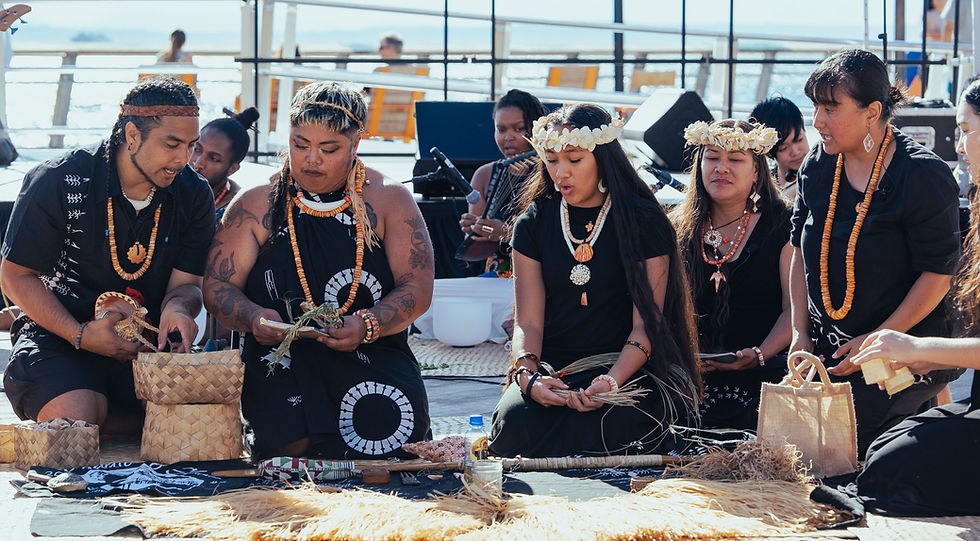Lawrence Atoigue: Discovering his roots
- Admin

- Jul 8, 2023
- 4 min read
Updated: Jul 8, 2023

By Johanna Salinas
Since the start of his art career, Lawrence Atoigue has gone by the name “Naturel,” not just to set him apart as an artist, but also to save people from mispronouncing his last name. “Coming home to Guam is the first time I don’t have to correct the pronunciation of ‘Atoigue,’” the artist said.
Atoigue was born and raised in Maryland. His family left Guam in the late 1970s for better opportunities. However, he desired more vibrant opportunities beyond suburbia. “The D.C. area, where I was raised, had its pitfalls, a lot of attributes that made me who I am. It’s still part of me,” Atoigue said. “Even though growing up in D.C., I felt like I could do better with becoming an artist. It’s not a great art town, it’s a great museum town. So, I spent 10 years in New York.”
After art school, Atoigue built a name for himself, creating art for Puma, Jhene Aiko, Beyoncé and Jay-Z. After spreading his wings across the globe, the artist wanted to come to Guam to gain a “better understanding” of his parents’ home island.
“’Better’ is a relative word; I would say ‘enriching’ is more appropriate for this journey,” Atoigue said. “Once you get your cup filled up in other places, it’s good to explore new horizons. I didn’t know a lot about where my parents came from, so coming here is a whole other chapter to this journey.”
Coming to a small island hasn’t slowed Atoigue’s creative projects. Despite being oceans away from any major cities, the artist is currently doing a partnership with Google.
The giant tech company approached Atoigue to be a part of the Google Pay partnership, which is a short list of creatives and cultural influencers that Google wants to foster an organic relationship with.
ADVERTISEMENT

“Folks like myself do things outside of the norm,” he said. “Google wanted to pair their products with people exploring life in different ways. They wanted to fuel my passion project. It was an open-ended question. I thought of everything and I was super reluctant to share this passion of mine to get into my cultural heritage.”
Atoigue showed Google a small deck he put together about him and his family moving to Guam. “The whole idea was documenting me getting in touch with my CHamoru heritage, not knowing anything about this. I’ve probably been the furthest from being interested in my cultural heritage. Not that I didn’t have CHamoru pride. It wasn’t relevant to what I was doing in the states. This is something I had to do, getting older and seeing what matters in my life with my kids, I wanted to show them.”
While painting is his forte, Atoigue has been curious about videography, which his daughter encouraged him to explore. “Months before this project, I dove into cameras and tried to educate myself on being in front of the camera,” he said.
Throughout his 10-year career as an artist, Atoigue never jumped in front of the camera as he always preferred to let his work speak for itself.
“My teenage daughter educated me about the value of putting yourself out there on social media, being a figure and speaking to your story,” he said. “Then Google came around and asked me to do all those things but through a Pixel phone.”
It simplified the tasks for him. Working with the phone keeps Atoigue and those around him in their comfort zone, as opposed to whipping out a big camera, which makes people nervous. “Everyone has a phone so no one thinks twice. Everyone acts natural. It’s a commonly used device,” Atoigue said. “It’s intuitive. Using the device stripped those things away and made it focused on telling the story.”

As he collected footage and connected to his CHamoru roots, an unexpected antagonist in the form of typhoon Mawar reshaped the project. “The typhoon isn’t necessarily in the project a lot, but what it did was answered a lot of open-ended questions present throughout the two-part documentary,” said Atoigue. “A lot of my documentary leaves a lot of open-ended questions: What’s my purpose? How do I participate in my culture? Since the typhoon, everybody was helping each other. That participation—me helping my community— felt like a crash course in being an islander. I went through an accelerated course in how to be a community member in Guam.”
Atoigue looks forward to releasing his documentary titled “No Man is an Island.” Coming to Guam connected Atoigue to the CHamoru culture. “The reason I wanted to come back is the longing to be a part of something. Knowing that I’m part of a people of a heritage I never knew,” he said. “I represent a good quarter million CHamorus who live off-island. Within that quarter million, I can assume there’s a number of disenfranchised members of the community.”
By admitting to his lack of familiarity with his own heritage through the project, Atoigue said he wanted to show others who might feel the same way that they are not alone. “The more we discover ourselves out there, the more we can become part of who we are and what we’re able to accomplish.”
Subscribe to
our digital
monthly edition






